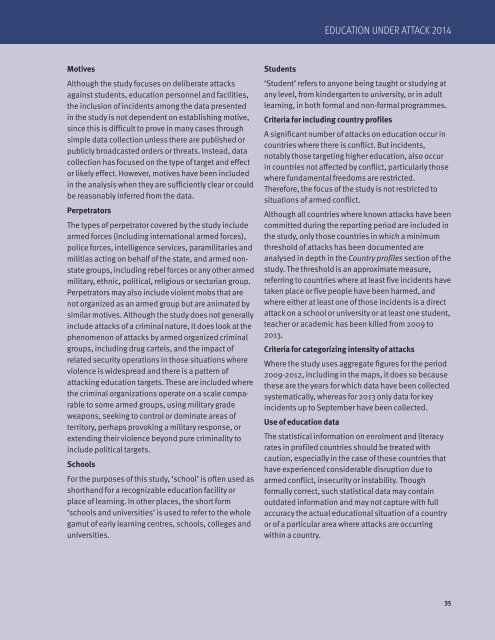You also want an ePaper? Increase the reach of your titles
YUMPU automatically turns print PDFs into web optimized ePapers that Google loves.
EDUCATION UNDER ATTACK 2014<br />
Motives<br />
Although the study focuses on deliberate attacks<br />
against students, education personnel and facilities,<br />
the inclusion of incidents among the data presented<br />
in the study is not dependent on establishing motive,<br />
since this is difficult to prove in many cases through<br />
simple data collection unless there are published or<br />
publicly broadcasted orders or threats. Instead, data<br />
collection has focused on the type of target and effect<br />
or likely effect. However, motives have been included<br />
in the analysis when they are sufficiently clear or could<br />
be reasonably inferred from the data.<br />
Perpetrators<br />
The types of perpetrator covered by the study include<br />
armed forces (including international armed forces),<br />
police forces, intelligence services, paramilitaries and<br />
militias acting on behalf of the state, and armed nonstate<br />
groups, including rebel forces or any other armed<br />
military, ethnic, political, religious or sectarian group.<br />
Perpetrators may also include violent mobs that are<br />
not organized as an armed group but are animated by<br />
similar motives. Although the study does not generally<br />
include attacks of a criminal nature, it does look at the<br />
phenomenon of attacks by armed organized criminal<br />
groups, including drug cartels, and the impact of<br />
related security operations in those situations where<br />
violence is widespread and there is a pattern of<br />
attacking education targets. These are included where<br />
the criminal organizations operate on a scale comparable<br />
to some armed groups, using military grade<br />
weapons, seeking to control or dominate areas of<br />
territory, perhaps provoking a military response, or<br />
extending their violence beyond pure criminality to<br />
include political targets.<br />
Schools<br />
For the purposes of this study, ‘school’ is often used as<br />
shorthand for a recognizable education facility or<br />
place of learning. In other places, the short form<br />
‘schools and universities’ is used to refer to the whole<br />
gamut of early learning centres, schools, colleges and<br />
universities.<br />
Students<br />
‘Student’ refers to anyone being taught or studying at<br />
any level, from kindergarten to university, or in adult<br />
learning, in both formal and non-formal programmes.<br />
Criteria for including country profiles<br />
A significant number of attacks on education occur in<br />
countries where there is conflict. But incidents,<br />
notably those targeting higher education, also occur<br />
in countries not affected by conflict, particularly those<br />
where fundamental freedoms are restricted.<br />
Therefore, the focus of the study is not restricted to<br />
situations of armed conflict.<br />
Although all countries where known attacks have been<br />
committed during the reporting period are included in<br />
the study, only those countries in which a minimum<br />
threshold of attacks has been documented are<br />
analysed in depth in the Country profiles section of the<br />
study. The threshold is an approximate measure,<br />
referring to countries where at least five incidents have<br />
taken place or five people have been harmed, and<br />
where either at least one of those incidents is a direct<br />
attack on a school or university or at least one student,<br />
teacher or academic has been killed from 2009 to<br />
2013.<br />
Criteria for categorizing intensity of attacks<br />
Where the study uses aggregate figures for the period<br />
2009-2012, including in the maps, it does so because<br />
these are the years for which data have been collected<br />
systematically, whereas for 2013 only data for key<br />
incidents up to September have been collected.<br />
Use of education data<br />
The statistical information on enrolment and literacy<br />
rates in profiled countries should be treated with<br />
caution, especially in the case of those countries that<br />
have experienced considerable disruption due to<br />
armed conflict, insecurity or instability. Though<br />
formally correct, such statistical data may contain<br />
outdated information and may not capture with full<br />
accuracy the actual educational situation of a country<br />
or of a particular area where attacks are occurring<br />
within a country.<br />
35



